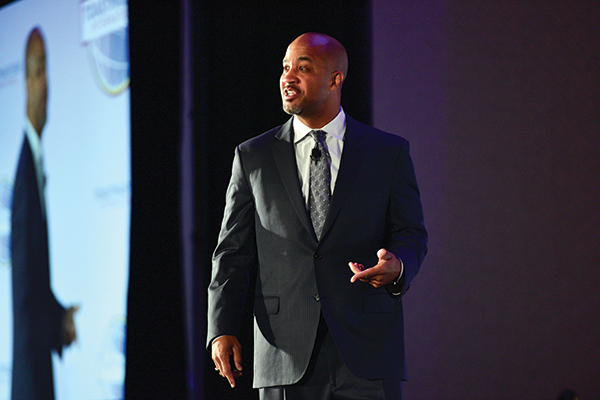
By Craig Valentine
Over the past 20 years, I’ve had some amazing opportunities to speak to audiences about the importance of leadership and presentation skills. The main tool I’ve used to accomplish this is storytelling. Storytelling helps both leaders and presenters motivate, inspire, and influence their listeners and be remembered.
Here are nine storytelling techniques I use that can help you breathe life into your next speech about a Rotary club project or fund-raising appeal.
1. Use a “foundational phrase.”
For each story, develop a foundational phrase your audience can easily remember and repeat. It should be audience-focused, simple to say, and preferably fewer than 10 words. For example, one of my foundational phrases is, “Don’t get ready; stay ready.” It sticks with my audience.
2. Get to your stories quicker.
There’s way too much setup (what I call the “pre-ramble”) for many stories. Get to the story and then go rapidly into the conflict and hook your audience.
3. Don’t be the guru of your own story.
The guru is the person who gives you the advice that helps you overcome your conflict and changes your life for the better.
I share a story of how I wanted to leave the company I worked for to live my dream of being a professional speaker. The vice president kept offering to raise my salary so I would stay. When I asked my wife what I should do, she said, “I don’t care how much they try to compensate you. Your dream is not for sale.” I left and spoke more than 160 times in one year. My wife is the guru of that story. Having a guru helps you remain similar to your audience.
4. Don’t just establish a conflict. Escalate it.
Think of it like the Titanic. Hitting the iceberg established the conflict, but then what happened? The water started rising. That escalation of the conflict led to a desperate need for a solution. You should show how your conflict escalates too.
5. Condense to connect.
When you deliver a scene with characters having dialogue, don’t tell us everything — just tell us the main thing. Try not to go back and forth between characters more than a few times, because your audience will grow tired. Instead, put the important statements in those few lines of dialogue.
6. Make your audience curious from the beginning.
What questions can you plant in their minds that they’ll want answered during the story? I start one story with, “The best leadership principle I ever learned was from the president of the United States in the early 1990s when I shared a golf cart with him.” My audience likely has one or more questions:
Which president?
How did you get to be in a golf cart with him?
What is the lesson he taught?
Because of the curiosity, my audience anticipates coming along on the journey with me. Tease them before you tell them.
7. Don’t keep repeating your message.
When your story is over and you’ve given your foundational phrase (that short phrase that is easy to remember and repeat), don’t ramble on about the point. The story actually makes the point, and the foundational phrase makes the point memorable. If you keep talking and trying to drive the point home, your audience will want the ride to end.
8. Create characters.
When delivering the lines of your characters, use their posture, positioning, and maybe a slight change in your voice to make that person come alive. You might have a character that is stern, has a stiff posture, and crosses their arms and frowns when talking. Become that character.
9. With a few exceptions, keep your stories short.
The longer you work on a story, the shorter it should get. It’s addition by subtraction. The story gets better not by what you put in but by what you remove. I try to keep mine under four minutes so I can leave my audience wanting more.
Craig Valentine is the 1999 World Champion of Public Speaking. This column is adapted from a December 2019 article in Toastmaster magazine. Rotary and Toastmasters International are working together to provide members of both organizations with more opportunities for personal and professional growth. Find out more.
https://blog.rotary.org/2024/04/04/9-tips-for-breathing-life-into-every-speech/
